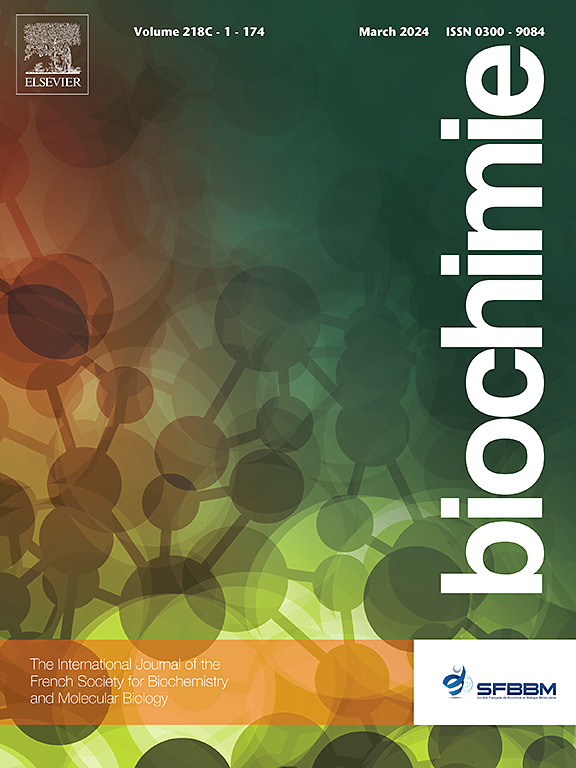Lipidomic analysis of MDCK-parental cells and MDCK-MDR1 cells exposed to GF120918 and clarithromycin highlights the role of P-glycoprotein in sphingolipid transport
IF 3
3区 生物学
Q2 BIOCHEMISTRY & MOLECULAR BIOLOGY
引用次数: 0
Abstract
P-glycoprotein (P-gp) is one of the most studied drug transporters, as it enables the cellular efflux of 50 % of marketed drugs and plays a key role in many drug-drug interactions. While a high number of studies has investigated the use of drug probes to phenotype P-gp activity, identifying endogenous markers remain a not fulfilled challenge. A previous untargeted lipidomic study in healthy volunteers highlighted some sphingolipid species as putative endogenous substrates of P-gp. Based on an untargeted lipidomic analysis of Madin-darby canine kidney parental cells (MDCK-parental cells) and MDCK cells transfected with the MDR1 gene (MDCK-MDR1), the present study aimed to investigate the role of P-gp in intracellular sphingolipid transport and, more generally, to demonstrate the interest of metabolomics strategy in the study of in vitro drug transporters. Using an untargeted lipidomic approach based on liquid chromatography high resolution mass spectrometry, allowed us to detect 131 sphingolipid species within MDCK-parental cells and MDCK-MDR1. Among them, modifications of this sphingolipidome were observed because of MDR1 transfection, mainly involving glucosylceramides. Exposure to two P-gp inhibitors, GF120918 and clarithromycin, increased glucosylceramides, particularly in MDCK-parental cells, probably due to expression of endogenous canine P-gp in this cell line. These results support the hypotheses of a role for P-gp as well as glucosylceramide flippase within the Golgi apparatus of cells. It also provides a proof of concept for understanding pharmaco-metabolomic results in the study of drug transporters in humans.
对暴露于GF120918和克拉霉素的mdck亲本细胞和MDCK-MDR1细胞的脂质组学分析强调了p -糖蛋白在鞘脂转运中的作用。
p -糖蛋白(P-gp)是研究最多的药物转运蛋白之一,因为它使50%的上市药物的细胞外排,并在许多药物-药物相互作用中起关键作用。虽然大量的研究已经研究了使用药物探针对P-gp活性进行表型分析,但识别内源性标记仍然是一个未完成的挑战。先前在健康志愿者中进行的一项非靶向脂质组学研究强调了一些鞘脂物种可能是P-gp的内源性底物。基于对Madin-darby犬肾亲本细胞(MDCK-亲本细胞)和转染MDR1基因的MDCK细胞(MDCK-MDR1)的非靶向脂质组学分析,本研究旨在探讨P-gp在细胞内鞘脂转运中的作用,更广泛地说,证明代谢组学策略在体外药物转运体研究中的作用。使用基于液相色谱-高分辨率质谱的非靶向脂质组学方法,我们可以检测mdck亲本细胞和MDCK-MDR1中的131种鞘脂。其中,鞘脂组因转染MDR1而发生改变,主要涉及糖基神经酰胺。暴露于两种P-gp抑制剂GF120918和克拉霉素中,葡萄糖神经酰胺增加,特别是在mdck亲本细胞中,可能是由于内源性犬P-gp在该细胞系中的表达。这些结果支持了P-gp和葡萄糖神经酰胺翻转酶在细胞高尔基体中的作用的假设。它还为理解人类药物转运体研究中的药物代谢组学结果提供了概念证明。
本文章由计算机程序翻译,如有差异,请以英文原文为准。
求助全文
约1分钟内获得全文
求助全文
来源期刊

Biochimie
生物-生化与分子生物学
CiteScore
7.20
自引率
2.60%
发文量
219
审稿时长
40 days
期刊介绍:
Biochimie publishes original research articles, short communications, review articles, graphical reviews, mini-reviews, and hypotheses in the broad areas of biology, including biochemistry, enzymology, molecular and cell biology, metabolic regulation, genetics, immunology, microbiology, structural biology, genomics, proteomics, and molecular mechanisms of disease. Biochimie publishes exclusively in English.
Articles are subject to peer review, and must satisfy the requirements of originality, high scientific integrity and general interest to a broad range of readers. Submissions that are judged to be of sound scientific and technical quality but do not fully satisfy the requirements for publication in Biochimie may benefit from a transfer service to a more suitable journal within the same subject area.
 求助内容:
求助内容: 应助结果提醒方式:
应助结果提醒方式:


